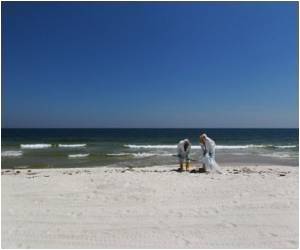Hungarian police and soldiers evacuated 800 villagers Saturday as authorities feared a second flood of toxic sludge from a chemicals plant was likely after new cracks appeared in a dyke.

The despairing and angry villagers were taken by bus to Ajka, the nearest major town which is 160 kilometres (100 miles) from the capital Budapest. Many placed the blame on MAL Hungarian Aluminium Production and Trade Company, which runs the plant whose sludge had swept through their homes.
"I feel really angry at the company because I feel they're responsible." said Jozsef Lengyel, who was just released from hospital on Thursday after being treated for burns on his lower body.
"I feel they think I'm stupid when they say this sludge isn't dangerous, because I've been burned up to my waist," the evacuated villager told AFP.
Hungarian Prime Minister Viktor Orban arrived in Ajka and admitted that another flood of toxic sludge seemed inevitable.
"The reservoir is so damaged that it is likely that it will give way for a second time," Orban said.
Advertisement
The first flood on October 4 released 1.1 million cubic metres (38.8 million cubic feet) of foul-smelling, blood-red toxic sludge into villages and rivers.
Advertisement
"The evacuation of Kolontar began at six in the morning (0400 GMT) after we noticed that the dam started weakening at tank number 10," Disaster Relief Team chief Tibor Dobson told AFP.
One of the new cracks was seven centimetres (three inches) wide, officials said.
The entire area was under surveillance, with helicopters with heat-detecting cameras in the air and 650 policemen on the ground coordinating rescue operations, the national police's website said.
Some of the evacuees were to stay with friends and relatives and those with nowhere else to go would be put up in the town's sports complex, officials said.
"There is despair and sadness, but no panic," said Orban of the mood among evacuees in Ajka.
Work was under way to build a new dam in Kolontar, in case of a new flood, to save those houses that were undamaged in the previous disaster, the Hungarian News Agency MTI reported.
The dam would be four to five metres (around 13 to 16 feet) high and made of earth and rocks, and would be ready in 48 hours.
The death toll from Monday's inundation of toxic sludge rose to seven on Friday, with one person still missing. The dead included a 14-month-old girl.
Around 150 people have been injured, many suffering deep burns, and include some of the first firefighters on the scene after the flood.
The prime minister meanwhile said there would be "consequences" after the unprecedented disaster, raising the possibility of action against the company running the plant. He also indicated that the Kolontar villagers would be provided for.
"Our house was the second next to the river, and everything has been destroyed in it. We've been told we can have a new house, either in Kolontar or elsewhere," Lengyel's daughter, Noemi, who was with the rest of her evacuated family in the Ajka sports centre, told AFP.
Nature protection organisation WWF meanwhile said Saturday that the reservoir had been leaking for months, publishing photographs on its website dating back to June.
"This new evidence of the degraded state of the walls and significant leakage more than three months before the incident should be cause for an urgent investigation, not just of this disaster but of the state of Hungary’s other toxic sludge ponds," Gebor Figeczky, the acting head of WWF's Hungarian branch, was quoted as saying.
"This points to neglect and a failure of regulation as a prime contributing factor to this disaster," added Figeczky.
The pollution already wiped out all life in the smaller Marcal tributary and experts say it will take up to five years for that river to recover.
It's estimated the red cloud of heavy metals is now affecting a 30km (19-mile) stretch of the River Danube.
Officials have insisted there was little risk for the Danube, Europe's second-longest river after the Volga.
Water samples taken Friday in the Danube above Budapest revealed a marked decrease in pollution levels with near-normal alkali, but the ecosystem of the Danube is still threatened.
The countries bordering the Danube, including Slovakia, Croatia, Serbia and Romania, have started regular checks of the river's water quality.
Disaster management officials have told the BBC they are cautiously optimistic that the Danube can be saved.
Huge quantities of gypsum and chemical fertilisers have been added to the waters of the Marcal and Raba rivers.
This action has a twin effect: to lower the dangerously high alkaline levels in the toxic red sludge which entered the river system after Monday's spill; and to bind the heavy metals in the water, where they can then be caught by dykes built in the bed of the Marcal and Raba, to prevent them flowing on to the Danube.
The distances are small. The Danube is only 45 miles (28 miles) from the village of Kolontar, the worst affect by the disaster.
The sludge is a by-product from the early stage of aluminium production, which leaked from storage reservoirs.
As part of the process, bauxite, the raw material, is taken out of the ground and washed with sodium hydroxide.
This produces alumina, which is processed further, and waste, which is composed of solid impurities, heavy metals, and the chemicals used as processing agents.
About 40%-45% of the waste is iron-oxide, which gives it the red colour.
Another 10%-15% is aluminium oxide, a further 10%-15% silicon oxide and there are smaller quantities of calcium oxide, titanium dioxide and sodium oxide, according to MAL Hungarian Aluminium.
Professor Paul Younger from the Newcastle Institute for Research on Sustainability at Newcastle University says the "fundamental problem is that it has a tendency to be strongly alkaline".
In the most concentrated areas, he says, it could be compared to products you would clean your kitchen with, causing dry or cracked skin, or - in cases of prolonged contact - it can "lift off the top layer of your skin".
Scores of people have already suffered burns in affected areas, with at least 120 receiving treatment.
"If you get it in your eyes it is also not good news," he adds.
The problem at the moment is the "heavy metal residue", as it is a danger for plant life and can get into rivers, says Dr John Hoskins, a consultant toxicologist,
He says that while it is unlikely that residents will be using the river directly for drinking water, it may pose a problem for water companies.
There are "real concerns" about the impact on the Danube, he says, as "it will increase the heavy metal content of the water and it might have adverse effects on fish".
Timea Petroczi, a spokesperson from disaster relief services in Hungary, told AFP that people had been told not to use the wells, as a "precautionary measure".
Those in affected areas have also been banned from eating home-grown foods, and from hunting or fishing.
Countries bordering the Danube have reinforced water quality controls and are monitoring the concentration of heavy metals.
Meanwhile, officials are treating affected areas with chemicals - such as calcium and magnesium nitrates - to try to counter the alkaline effects.
Source-Medindia









